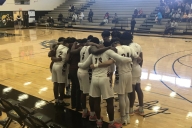You have /5 articles left.
Sign up for a free account or log in.
Many faculty members may resent the money and power big-time athletics programs wield on campus, but the fact is that college sports are bigger than ever and they’re not going anywhere. With that in mind, the Division I Faculty Athletics Representatives Board, which represents the designated academic-athletic department liaisons/watchdogs at Football Bowl Subdivision institutions nationwide, proposed its own plan detailing how the National Collegiate Athletic Association should be restructured.
NCAA governance has been a hot topic of late, with major conference commissioners calling for a new (or sub-) division that would permit their programs more freedom in rule making and spending, and theoretically make NCAA governance more streamlined and efficient. At least one of those commissioners has said he wants faculty involvement in the process, which will get under way at the NCAA’s annual convention in January and could be finalized as soon as August.
The 1A FAR Board’s recommendations advocate for a new, separate division (as opposed to a subset of Division I) for FBS programs, which include the 10 wealthiest and most powerful athletic conferences (plus the University of Notre Dame, in football only). Currently, Division I includes those programs plus the smaller-scale Football Championship Series ones. The FAR plan also recommends the consolidation of some NCAA councils, cabinets and committees, with broader representation of upper-level athletic administrators and representatives, including – you guessed it – FARs.
Inside Higher Ed conducted an e-mail interview about the plan and the role of faculty in NCAA matters with Brian Shannon, president of the 1A FAR Board and a law professor at Texas Tech University, and the past president Josephine R. Potuto, law professor at the University of Nebraska. Excerpts of their responses follow.
Q. Was this report solicited by the NCAA? Are they -- or other presidents, conference commissioners or athletics directors -- asking you for advice on this issue?
Shannon: Yes, in part. In early September, the NCAA solicited input from FARs, presidents/chancellors, conference offices, and others on the future governance and structure for Division I. The NCAA requested that responses be provided prior to Nov. 15. The 1A FAR Board had already begun work on our proposal prior to the NCAA solicitation, however, given that the NCAA had previously scheduled a “Division I Governance Dialogue” program for the January 2014 NCAA Convention.
Potuto: The 1A FAR Board already had its governance model ready to go. We thus were positioned to advocate and move policy rather than simply react to policies developed by others. I guess you could say we responded to the general invitation before it was sent.
Many faculty members feel disempowered when it comes to athletics issues, that their voices are excluded. Does this happen often, and what are the consequences with respect to the broader conversation about how college athletics should be run, both nationally and on individual campuses?
Shannon: There have been occasions when the FAR voice has not been sought on certain issues. Part of our mission as the 1A FAR (association) has been to advocate and address issues unique to Division I FBS institutions, and to consistently urge a careful balancing of academic versus athletics interests, and to maintain a focus on student-athlete welfare and not solely on competitive success….
On our individual campuses, the FAR often serves as the eyes and ears of his or her president/chancellor with regard to the intersection of athletics and academics, but by also being a faculty member, the FAR can also be a bridge to others in his or her faculty community. Moreover, as we noted in our proposal, the 1A FAR Board believes strongly that FBS governance would be much better-served (and a true diversity of perspectives more easily achieved) by centering discussion and policy resolution in a group of FARs, athletics administrators, and conference commissioners exclusively from the FBS.
Potuto: Intercollegiate athletics, by definition, is athletic competition engaged in by students who are enrolled at colleges and universities. There is no issue that is exclusively athletic or exclusively one for consideration by the greater campus. It is imperative that all ramifications of NCAA policy and bylaws are explored and the negative consequences avoided, or at least ameliorated.
The best-articulated policy comes from robust discussion with all stakeholders at the table. That cannot happen when governance is siloed, with athletic directors and FARs in different rooms discussing different policy questions -- or discussing different aspects of the same general policy. One major risk is that the values and ethos of higher education are sublimated to the requisites of maintaining high level competition or the visibility of athletic teams and programs. The critical issue here is not a parochial, self-interested one regarding whether FARs feel disenfranchised, but whether the overall health of intercollegiate athletics can be maintained if the FAR voice and perspective are marginalized or excluded.
The critical issue here is not a parochial, self-interested one regarding whether FARs feel disenfranchised, but whether the overall health of intercollegiate athletics can be maintained if the FAR voice and perspective are marginalized or excluded.
-Josephine Potuto, U. of Nebraska
Q. On that note, what does the D1 FAR report add to this ongoing debate about NCAA structure and governance?
Shannon: The 1A FAR Board supports … a new, separate, NCAA division to be able to group together institutions that are more closely aligned in resources dedicated to athletics programs and in the types of issues faced. Doing so would allow smaller governance groups that can include more senior-level athletics administrators and FARs with broad-based responsibilities than is possible under the current structure, and the new governance groups and board could focus directly on FBS issues and be better positioned to resolve issues and provide workable and needed solutions for FBS institutions.
We also were very purposeful in setting forth a list of critical objectives for any new form of governance. Our plan sets forth one set of ideas. There will no doubt be others. The 1A FAR Board wants to assist in trying to converge ultimately on the best approach that is good for the NCAA and our member institutions and student-athletes. By linking any new structure to specific goals and objectives, we believe we have created a mechanism for moving forward in a principled fashion.
Potuto: Moving to a new governance model obviously will require consensus as to governing principles and objectives to be achieved. That is the easy part, however. What is tricky is figuring out how to make those principles and objectives operational. Until one works with a concrete proposal one is flying in the sky of abstraction…. We of course hope that our model will be adopted in toto. At the very least, we expect that our model will form a framework for discussion.
Q. Your plan largely maintains presidential control, even as some critics (and presidents, such as Holden Thorp, who just left the University of North Carolina at Chapel Hill) have said athletics is such a pervasive issue it either becomes the number-one job or is just too much to handle. Does your plan take that into account, or rethink presidential control at all to account for the extreme growth of college sports since the NCAA's last restructuring?
Shannon: We firmly believe that presidents and chancellors must have ultimate authority for the direction of intercollegiate athletics and for setting the policy and bylaw goals to be achieved. But, by creating an additional, streamlined Management Council comprising FARs, athletics directors, and possibly conference commissioners and senior woman’s administrators, we have endeavored to create a body made up of persons more directly involved with athletics and academics on a daily basis to develop and implement the details of such policies and legislation, and to carry out the goals and objectives established by the new FBS board. Doing so, we believe, would allow those charged with implementing policies and bylaws to have substantial input in their development and, in turn, greater buy-in from member institutions.
Potuto: Ultimately, presidents and chancellors need to be in control. Period. End of discussion. They can maintain control by attempting to “know” athletics, by drafting policy and by resolving issues themselves, or they can maintain control by setting overriding policy and leaving it to those with on-the-ground experience and expertise to make policy operational. I doubt any chancellor or president would believe she should administer the law and medical schools by “knowing” legal or medical issues the way the law and medical school faculties do. I am certain they would not undertake to do a trial or surgery.
The difficulty with the current NCAA Division I governance model is that, for a variety of reasons, the presidents and chancellors on the Division I Board increasingly moved to a model in which they not only articulated overriding policy but themselves undertook to make it operational. Frequently they did so by circumventing the regularized process that allowed for campus evaluation of policy and proposed bylaws. One reason this happened is that the Division I Management Council (now the Leadership and Legislative Councils) was too big and diverse to operate efficiently. Another reason was that governance was buried in the minutiae of a regulatory model of governance.
The 1A FAR Board governance model attempts to resolve these problems by moving to a much smaller division, with institutions and conferences that have more in common; by moving the operational policy function back to those with on the line experience; and by assuring that a critical mass of FARs and ADs are engaged TOGETHER in resolving issues and implementing Board policy.
Is there any concern that a separate FBS division, rather than another subdivision of D1, will accelerate the divide between the "haves and have-nots" if the biggest programs only have to worry about themselves?
Shannon: That type of divide has been moving forward for a number of years and will likely continue regardless of the NCAA’s future governance structure. As we noted in our report, the 1A FAR Board believes that the FBS must be the master of its own fate, particularly with regard to matters of enhancement of the student-athlete experience that depend on revenue allocation.
Potuto: There is nothing, at least nothing within the range of the possible, that will erase the divide between the “haves and have-nots.” We can continue to live, with Alice, on the other side of the Looking Glass. The likely result is continued immobilization from making effective change and, I would say, from doing all we should do to enhance student-athlete well-being and the student-athlete experience. Or we can acknowledge the obvious and begin to build a governance structure that can operate effectively and efficiently. The 1A FAR Board opted for the latter course.
How does your plan ensure that the welfare of students and academics will be preserved?
Shannon: We believe that student-athlete welfare and academic opportunities for student-athletes who attend FBS institutions will be preserved and even enhanced if our proposed structure could be implemented. By utilizing a group of FARs, athletics administrators, and conference commissioners exclusively from the FBS for policy development, those closest to the day-to-day campus activities can play an integral role.
Student-athlete welfare and academic opportunities for student-athletes who attend FBS institutions will be preserved and even enhanced if our proposed structure could be implemented.
--Brian Shannon
Potuto: How money is spent in college athletics, at least among the major FBS programs, is a question of distribution of revenues as much as it is the amount of revenues to be distributed. Lesser-resourced schools spend their revenues on things they believe will help them to become or stay competitive, namely coach salaries and facilities. Claims of competitive balance then lead these lesser-resourced schools from agreeing to adopt bylaws that would permit better-resourced schools also to spend money on things that would inure to student-athlete well-being – scholarships that cover the full cost of attendance as one example.
Grouping the “have” schools and conferences together should impel them to spend money on student-athletes and their well-being unimpeded by negative votes from schools and conferences that believe they cannot afford to do it too. In addition, a smaller governance structure means that the FAR/campus perspective can be included in critical mass numbers.








